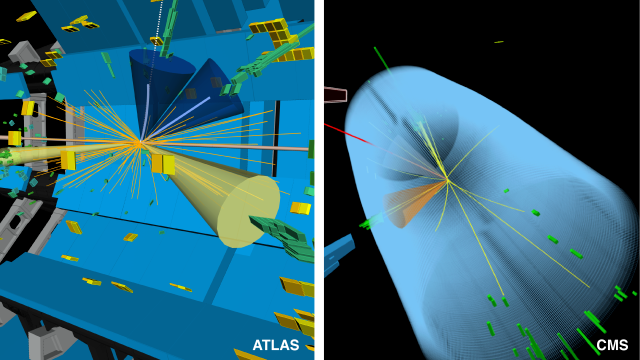Asymmetries, like symmetries, make the whole world go round. One example is charge-parity (CP) asymmetry, which is needed to clarify why matter massively outnumbers antimatter in the present-day universe even though both forms of matter should have been formed in equal amounts during the Big Bang.
 ATLAS (left) and CMS (right) candidate events for a Higgs boson decaying into a pair of tau leptons. Image Credit: CERN.
ATLAS (left) and CMS (right) candidate events for a Higgs boson decaying into a pair of tau leptons. Image Credit: CERN.
The Standard Model of particle physics, which perfectly represents the building blocks of matter and their interrelations, includes sources of CP asymmetry, some of which have been proved experimentally. Moreover, the quantity of CP asymmetry generated by these Standard Model sources is far too limited to account for the universe’s matter–antimatter imbalance, urging physicists to search for potential sources of CP asymmetry.
The international ATLAS and CMS partnerships at the Large Hadron Collider (LHC) recently turned to the Higgs boson, which they found ten years ago, to see if this unique particle conceals a unique, unnamed source of CP asymmetry.
The ATLAS and CMS teams had originally looked for CP asymmetry in the interactions of the Higgs boson with other bosons as well as the heaviest known fundamental particle, the top quark, but found no evidence of it. ATLAS and CMS looked for this asymmetry in the interaction between the Higgs boson and the tau lepton, a thicker variant of the electron, in their most recent studies.
To look for this asymmetry, ATLAS and CMS first looked for the Higgs bosons “decaying” into pairs of tau leptons in proton–proton collision evidence gathered by the experimental tests during the LHC’s second run (2015-2018).
They then examined the motion of this decay, or “kinematics,” which is determined by an angle known as the mixing angle, which evaluates the quantity of CP asymmetry in the interaction between the Higgs boson and the tau lepton.
In the Standard Model, the mixing angle is zero—hence the engagement is CP symmetric, which means that it remains constant when a particle is swapped with the mirror image of its antiparticle.
Moreover, in theories that stretch the Standard Model, the angle can deviate from zero, and the interaction can be explicitly or implicitly CP asymmetric based on the direction—and an angle of -90° or +90° equates to a completely CP-asymmetric interaction, while any angle in between, except 0 degrees, equates to a partially CP-asymmetric interaction.
The ATLAS team got a mixing angle of 9° ± 16° and the CMS team -1 ± 19° after evaluating their samples of Higgs boson decays into tau leptons, both of which avoid a completely CP-asymmetric Higgs boson-tau lepton interaction with a significance level of about three standard deviations.
Within the current high precision, the findings are consistent with the Standard Model. More information will enable scientists to either verify this inference or detect CP asymmetry in the Higgs boson-tau lepton interaction, which would have a significant impact on the understanding of the universe’s origins.
With the third run of the LHC set to begin shortly, the ATLAS and CMS partnerships will not have to wait long to power more information into their analysis kits to determine whether the Higgs boson conceals a new source of CP asymmetry.